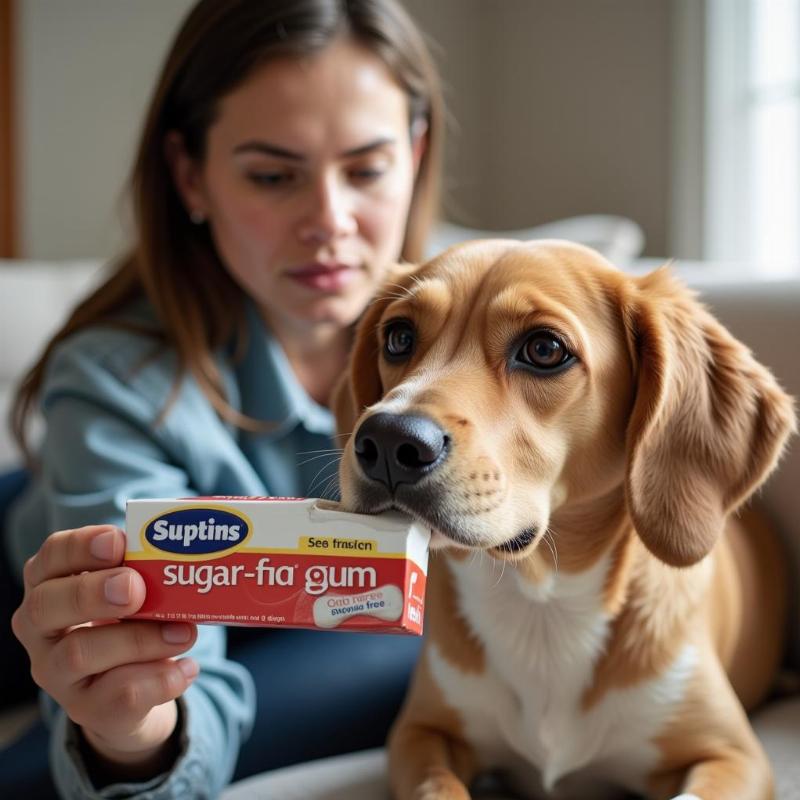If your dog snagged a piece of chewing gum, you’re likely worried. Understanding what happens if a dog eats gum is crucial for responsible pet ownership. While a small piece of sugar-free gum might not cause significant harm, the real danger lies in xylitol, an artificial sweetener commonly found in sugar-free gums and candies. Xylitol is extremely toxic to dogs. This article will explore the potential dangers of gum, symptoms of xylitol poisoning, and what to do if your dog ingests gum.
The Dangers of Xylitol in Gum for Dogs
Xylitol is rapidly absorbed into a dog’s bloodstream, causing a surge in insulin release. This leads to a drastic drop in blood sugar, a condition known as hypoglycemia. Severe hypoglycemia can cause weakness, seizures, liver failure, and even death. Even small amounts of xylitol can be dangerous. The size and breed of your dog also play a factor in how severely they react. Smaller dogs are more susceptible to xylitol poisoning. Additionally, some gums contain other ingredients that can upset a dog’s stomach, such as artificial flavors and preservatives. Even regular gum with sugar can contribute to dental issues and weight gain in dogs.
 Xylitol Gum: A Danger to Dogs
Xylitol Gum: A Danger to Dogs
Symptoms of Xylitol Poisoning in Dogs
Symptoms of xylitol poisoning can appear quickly, sometimes within 15-30 minutes of ingestion. It’s crucial to recognize these signs and act fast:
- Vomiting
- Weakness, lethargy, or difficulty walking
- Loss of coordination
- Tremors or seizures
- Collapse
- Jaundice (yellowing of the skin and gums)
What to Do if Your Dog Eats Gum
If you suspect your dog has ingested gum containing xylitol, contact your veterinarian or the ASPCA Animal Poison Control Center immediately. Time is of the essence. Do not induce vomiting unless instructed to do so by a veterinarian. Be prepared to provide information about the type of gum, the amount ingested, and your dog’s weight and breed. The sooner your dog receives treatment, the better the prognosis. Your veterinarian may induce vomiting, administer activated charcoal to absorb the toxin, or provide intravenous fluids to stabilize blood sugar and support liver function. can dogs eat pork chops bones
Preventing Xylitol Exposure
Prevention is always better than cure. Keep all gum, candies, and other products containing xylitol out of your dog’s reach. Be mindful of guests and family members, ensuring they don’t accidentally leave gum where your dog can access it. When shopping for human treats, always check the ingredients list for xylitol. Educate yourself and your family about the dangers of xylitol for dogs.
How to Identify Xylitol on Product Labels
Xylitol might not always be prominently displayed on a product label. Look for other names it might be listed under, such as:
- Birch sugar
- Wood sugar
- E967 (European food additive code)
Is Any Gum Safe for Dogs?
No gum is safe for dogs. Even if it doesn’t contain xylitol, the other ingredients can be harmful or cause digestive upset. Chewing gum can also be a choking hazard, especially for small dogs. dog gums bleeding when chewing bone
Conclusion
Xylitol in gum is a serious threat to dogs. Knowing the signs of xylitol poisoning and acting quickly can save your dog’s life. Be vigilant about keeping xylitol-containing products out of your dog’s reach. If your dog ingests gum, contact your veterinarian or the ASPCA Animal Poison Control Center immediately. how often do dogs teeth need to be cleaned tomcat mouse killer dog eat
FAQ
-
How much xylitol is toxic to dogs? Even small amounts can be toxic. The toxic dose can vary depending on the dog’s size and breed.
-
What are the long-term effects of xylitol poisoning in dogs? Liver failure can be a long-term consequence of xylitol poisoning.
-
Can dogs recover from xylitol poisoning? With prompt and aggressive treatment, many dogs can recover fully.
-
Are there any safe alternatives to gum for dogs? There are dog-specific chew toys and treats designed to satisfy their chewing instincts.
-
What should I do if my dog eats regular gum (with sugar)? Monitor your dog for any signs of digestive upset and contact your veterinarian if you have any concerns.
-
How can I tell if a product contains xylitol? Carefully read the ingredients list. Xylitol might also be listed as birch sugar or wood sugar.
-
Is xylitol toxic to other pets? While it’s most toxic to dogs, it can also be harmful to other animals, including ferrets and rabbits.
Beautdogs.us is your trusted source for comprehensive and engaging information on dog care, breeds, and products. We offer expert advice for both new and experienced dog owners. From understanding the dangers of everyday items like gum to providing breed-specific guidance, Beautdogs.us is dedicated to helping you provide the best possible care for your furry companion. Contact us for more information! Email: [email protected], Phone: +1 501-555-7529.